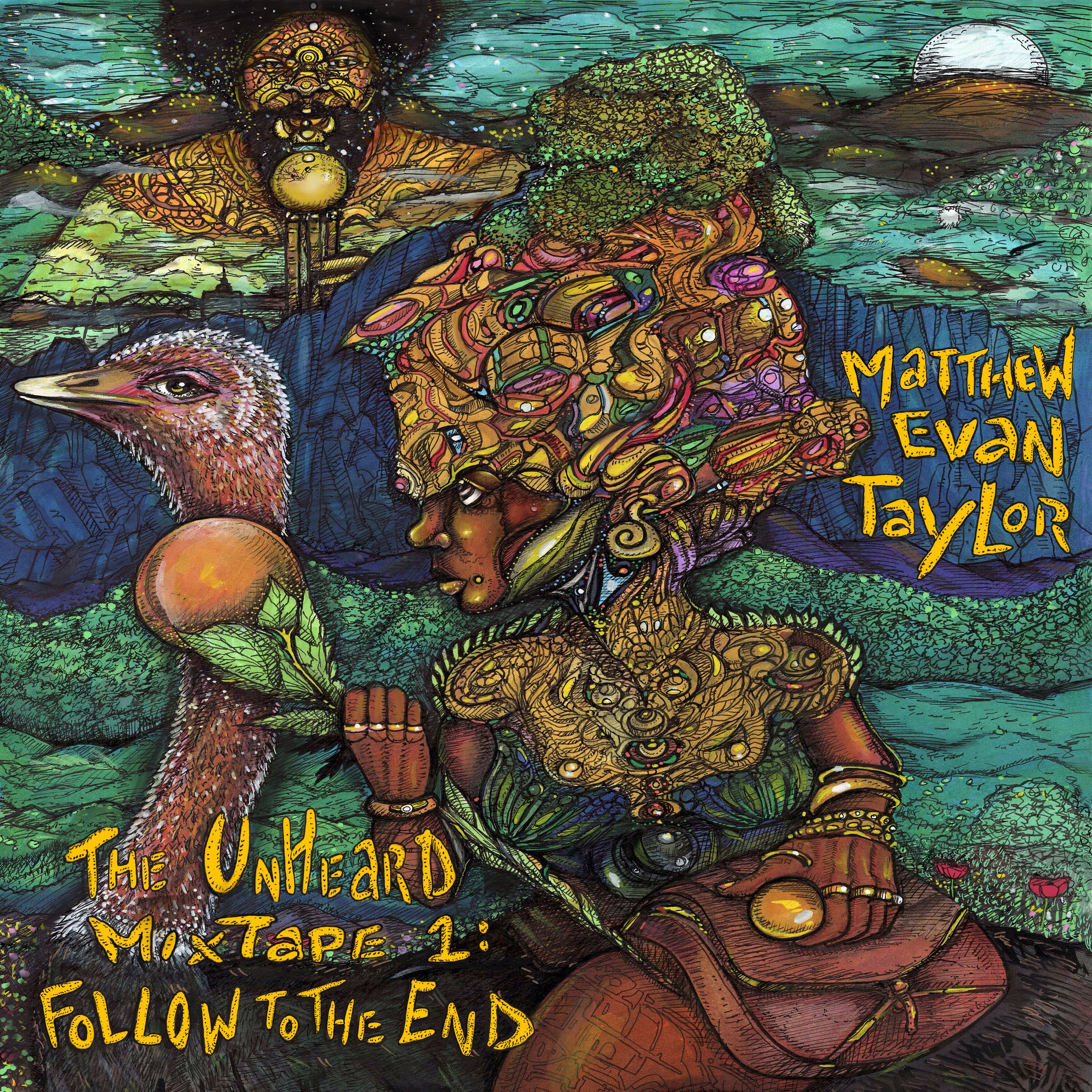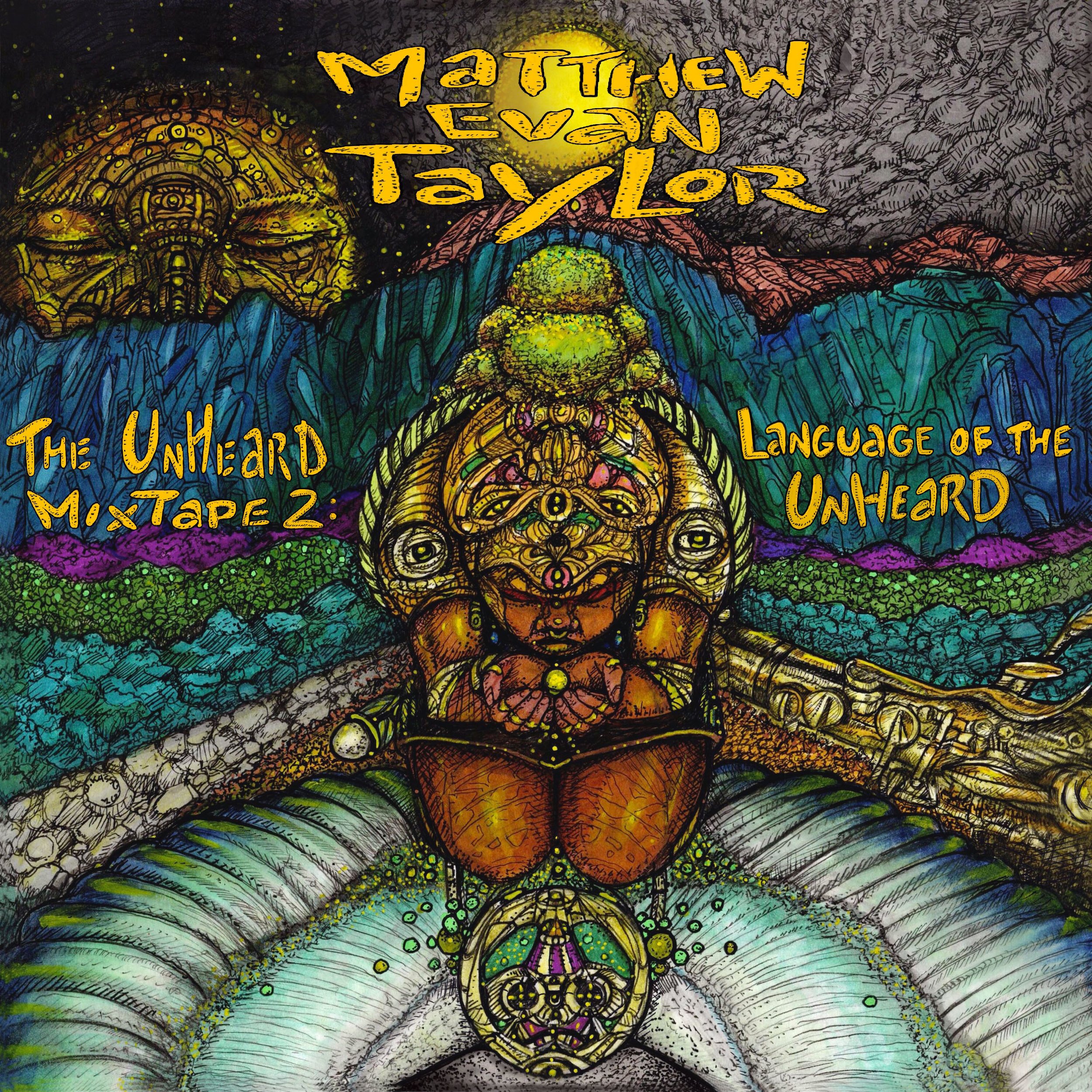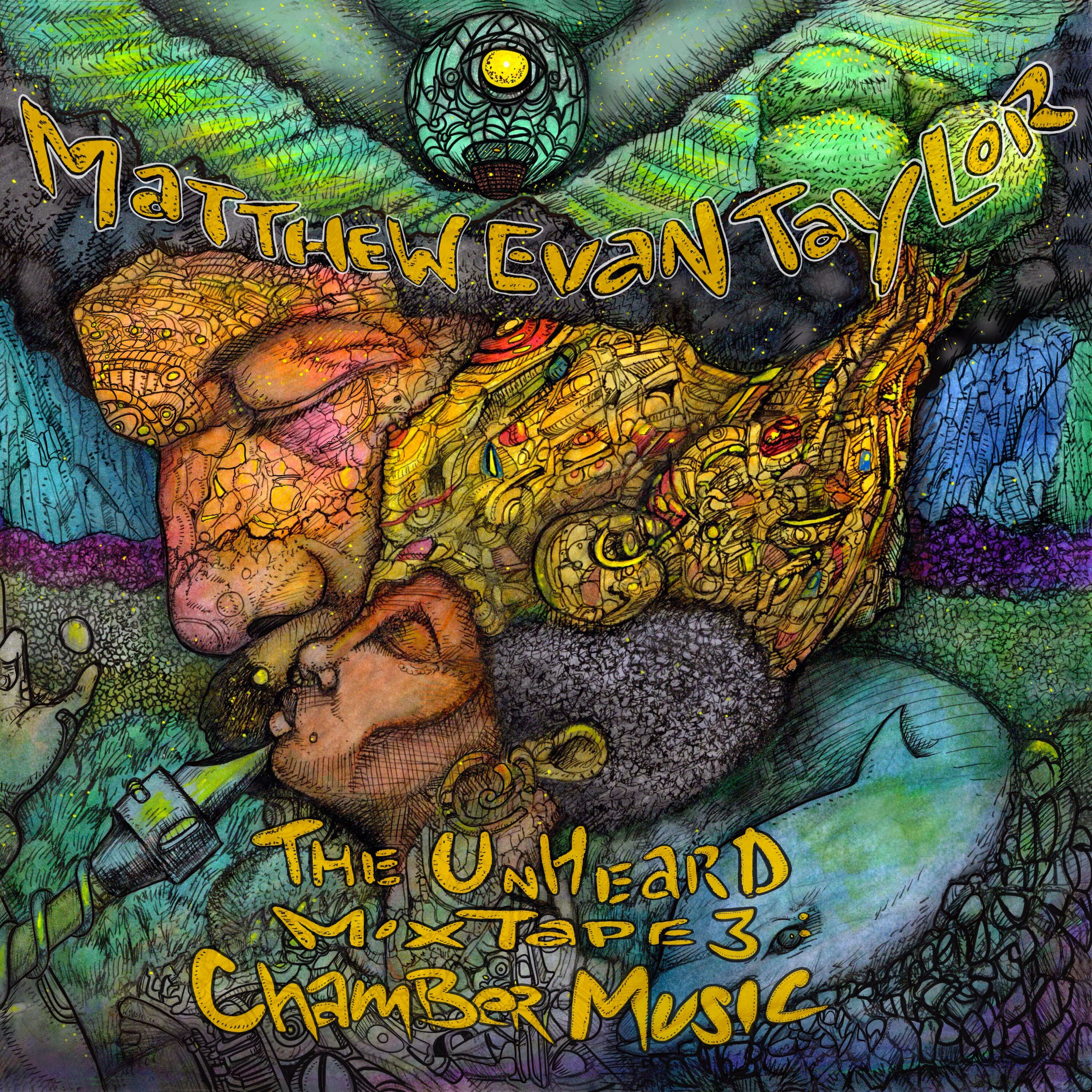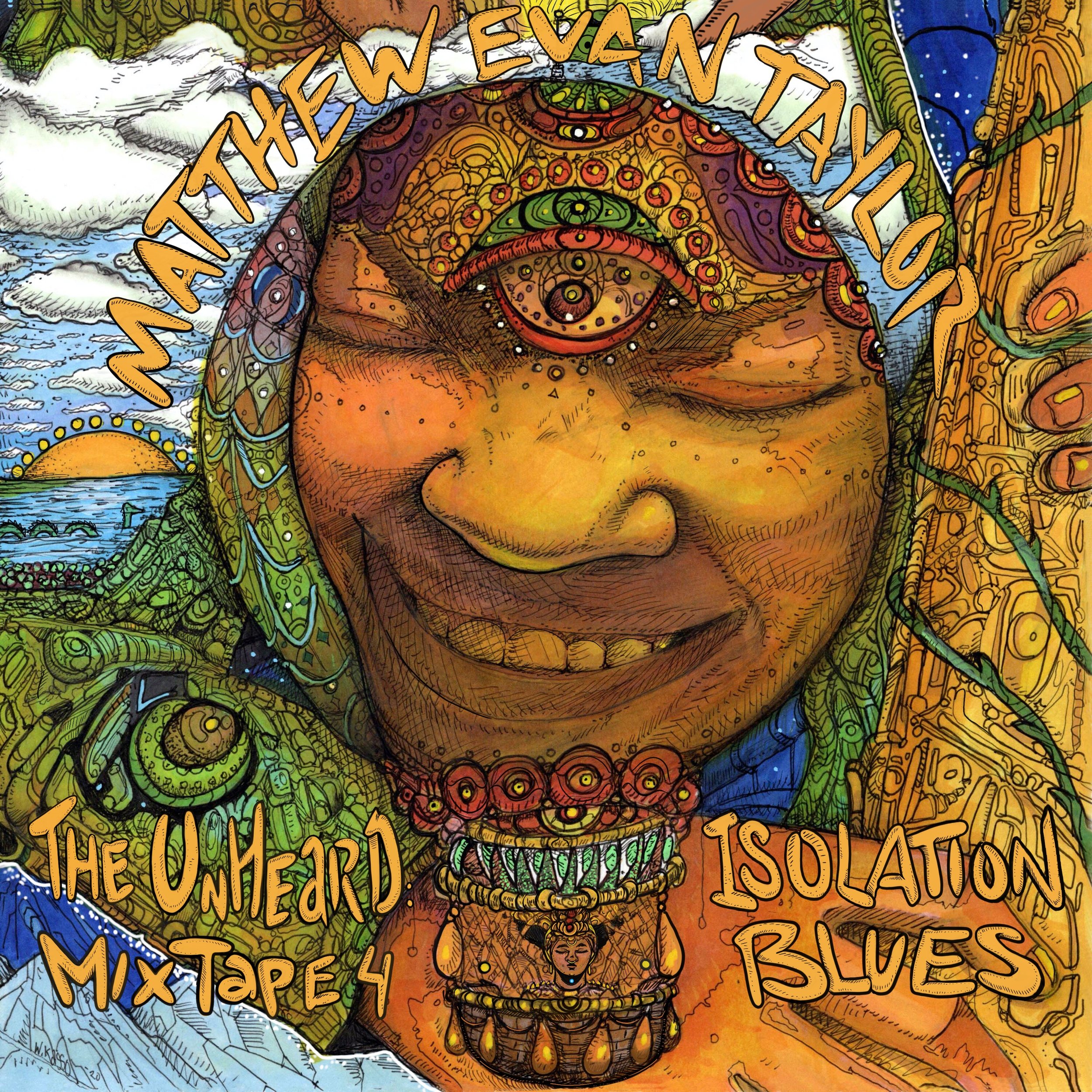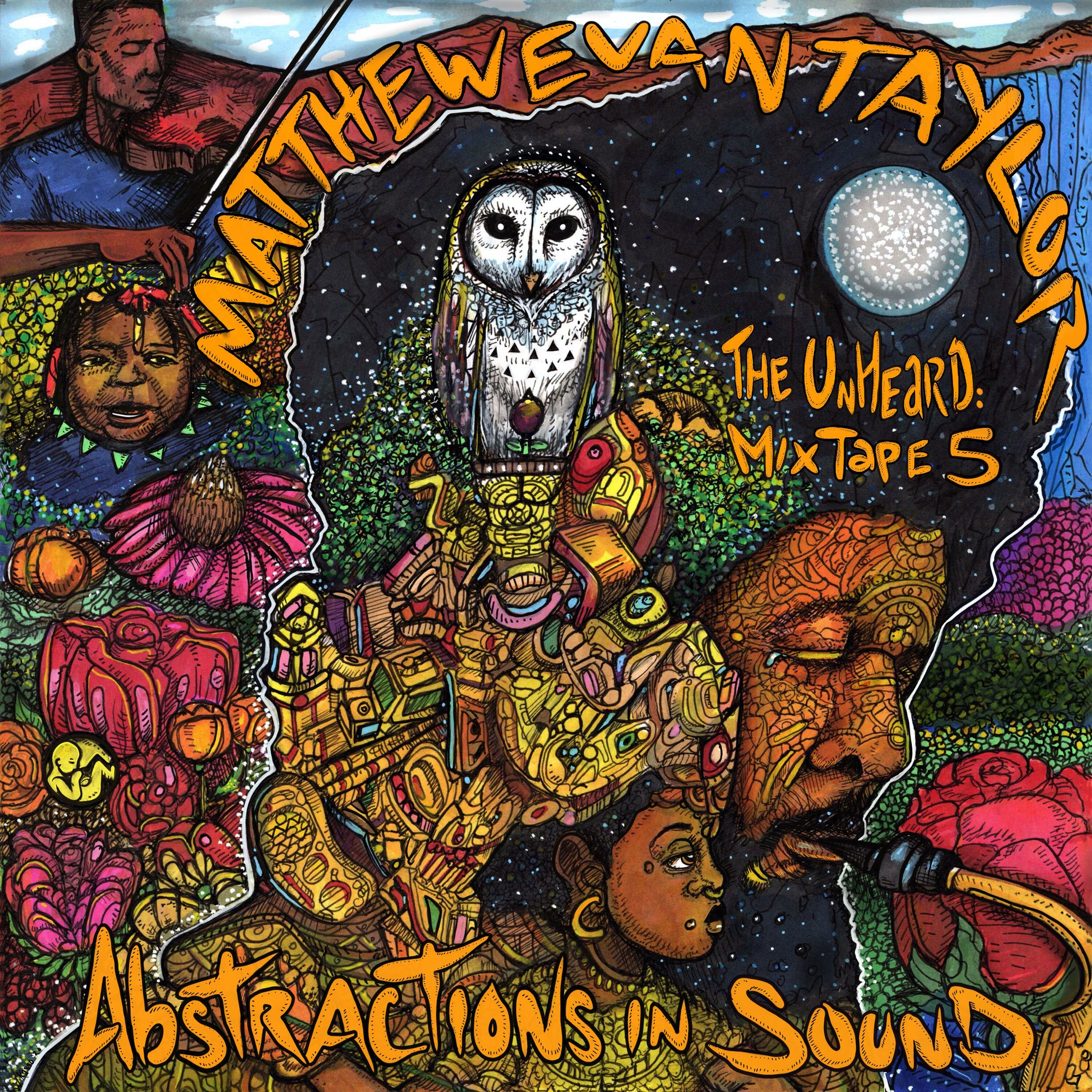“Matthew reconciled his artistic identity as a classical composer focused on social justice, Black expressive culture, and experimentalism.”
(I Care If You Listen)
About the Album
Released September 29, 2020 on New Amsterdam Records
A five-part series commissioned by Metropolis Ensemble, released on New Amsterdam Records. Composer and saxophonist Matthew Evan Taylor’s The Unheard Mixtapes — his self-described artistic manifesto during the pandemic — was unveiled over five months from September 29, 2020 to January 26, 2021. Artwork by Juniper Creative LLC (Will Kasso Condry, Jennifer Herrera-Condry, Alexa Herrera-Condry).
Taylor has a long and ongoing fascination with the dissemination of art through underground or backdoor channels, such as zines and mixtapes. He explains that “not only have these methods proved to be effective means of delivering art to people without the focus on commercial gain, but they often give insight into the character and taste of the curators of the material. I see the mixtape, especially as it is used in the hip hop community, as a wholly American (specifically African American) genre akin to the string quartet or song cycle.”
Mixtape 1: Follow to the End, begins a plaintive and epic odyssey in which Taylor explores, and ultimately achieves, the fraught goal of being himself. He boldly states in his notes for the project: “I am Matthew Evan Taylor, a musician who composes; a composer who performs; a performer who improvises. I am all of these things and more. The Unheard Mixtapes are my manifesto.”
Mixtape 2: Language of the Unheard begins a plaintive and epic odyssey in which Taylor explores, and ultimately achieves, the fraught goal of being himself.
Mixtape 3: Chamber Music as a collection of works, stands as the sole [mixtape] with overt references to Western classical music. The music however lies in a space that transcends Western classical music, drawing upon the visual, physical, and spiritual worlds in a richly unique tapestry of color, movement, time and space.
Mixtape 4: Isolation Blues, as writer Rick Moody writes in the project's liner notes, "The thing about Matthew EvanTaylor is the emotional intensity of what comes out of him, which is mostly associated with his horn, but not exclusively, at all, because it’s like his every gesture is consistent with the practice."
Mixtape 5: Abstractions in Sound, as composer Anthony R. Green writes in his liner notes for the project, "In Matthew Evan Taylor's Abstractions in Sound, his intimate musical crevices are laid bare for listeners to examine, absorb, intimate. The album, though separated into six distinct improvisations, suggests a journey containing a single path through various terrains, each with their own unique, rich crevices. Suffice it to say, this ultimately left-to-right journey is rife with micro- and macro-wanderings through space and time via musical phenomena: microtonal inflections, multiphonics, licks, vibrato extremes, tone beauty, tone ugliness, the harmonic series, vocal modulations, interruption, saturation, and so much more."
Recent Reviews
“I felt connected to much older traditions and wisdoms about sound, and the relationship that the act of making music has to connecting with the past.”
Matthew Evan Taylor
Matthew Evan Taylor has collaborated closely with Metropolis since 2016, with projects that include Biophony, For the Birds, and our multi-year partnership with The Metropolitan Museum of Art, Life Returns / Postcards to The Met.
WATCH: Trailer for the five-part album series, The Unheard Mixtapes.
Project In-Depth
Though recorded during our current pandemic reality, the lo-fi/DIY mixtape ethos is the confluence of a longstanding aesthetic to which Taylor has been drawn. Each album features original art from the team at Juniper Creative, LLC which includes renowned street artist and muralist Will Kasso Condry, his wife Jennifer Herrera-Condry, and daughter Alexa Herrera-Condry.
-
Released September 29, 2020
First Sunrise
The Anguish of Knowing
Work Song and Rebellion
No Compass
Follow to the End
Sunset
—
Notes by Matthew Evan Taylor
Self-awareness is hard to come by.
For the better part of three decades as a musician I have tried to conform to what was expected of me. In my teens and early 20s, I played the part of the affable jazz front man, playing standards in small clubs in Birmingham, AL while people ignored the band, asked us to turn it down after we played a ballad like “In a Sentimental Mood,” or asked if they could come up and play my sax. The end of this period was punctuated by auditions I took for master programs in saxophone performance. At one school, the white guy that ran the jazz department told me that I was “too classical” for his program. His colleague at the school disagreed – this man thought I was “too jazzy” to study classical saxophone.
In my mid-20s, I was the silent and imposing black guy in an otherwise all-white rock band. Afraid to be compared to Bruce Springsteen or, worse, Dave Matthews, “we” decided that I should switch to playing keyboards. I rocked out to simple songs that got to be way too boring for the excitement I was trying to sell. This particular persona garnered me my first “real success” as a musician; my bandmates and I were signed to a major label, toured the US and Canada for two years, and recorded some music. Our album was released, it went nowhere, the music industry crashed, and by 2008 we had all gone our separate ways.
In my late 20s into my 30s, I decided to go back to school and try my hand at composing. I began taking lessons privately with my college theory professor, the incredible composer Dorothy Hindman. To support the lessons and allow myself some time to recover from life in popular music, I began working as an exceptional-needs aide at an elementary school in a suburb of Birmingham. My colleagues and I had an unbreakable bond as we supported children that others were ill-equipped to care for. I got to make up games on the spot to help my little friends learn and, sometimes, heal. We as a group engaged in a type of group improvisation, in which we considered the mood of the children on a given day, new medications they may be on, and the more mundane day-to-day stressors of being a child in elementary school. This was a really happy time in which I felt I had a purpose. I only played music on my terms, and I happily punched a clock five days a week.
Eventually, at the urging of my composition teacher, I applied for and was accepted into the Master of Music program at the University of Miami, Frost School of Music. I moved to Miami August of 2009. Despite my acute imposter syndrome, I developed relationships with amazing mentors and began working with incredible musicians like Elliott Sharp, Tatsuya Nakatani, and Marilyn Crispell. I also built a name as a classical composer. But in this period of my life, I still wasn’t completely sure who I was. I dealt with the mind-fuck of what it means to be a BLACK composer; should I lean into my jazz roots, or should I deny them? Do I benefit from having a “white” name or should I emphasize my blackness? Will I be pigeon-holed for having my music performed alongside other black composers in a concert dubbed “Classical Roots” presented on the second Saturday of Black History Month?
While I was struggling with these questions of identity, I also understood that I couldn’t rely on “tradition” or pedigree to move me through this thorny world. I had to create my own path. I began organizing improvisational concerts with friends, forming the group Fridamusiq. In this group, I felt like myself. We played, wrote poetry for each other, and experimented. This group, a collection of four misfit composers, was the first time I felt at home. It rekindled a feeling of belonging that I felt at the elementary school in Birmingham.
Group improvisation with open-minded people, that is my happy place. That’s what my colleagues and I at the elementary school were engaging in, and Fridamusiq’s raison d’etre. But, I still felt that the future for me lay in specialization in classical music. The available evidence supported that view at the time, including orchestra performances by the Detroit Symphony and the Cleveland Orchestra. Admittance into festivals in Italy and New York also seemed like proof that I was doing the right thing. In truth, I was. But I didn’t see the full picture. I didn’t understand that I didn’t need to deny a part of me to advance my career. I was chasing my tail trying to please the establishment when I have never been a follower. All the while, I was shunting my race and the freer portions of my identity to the side in order to please…who?
I finally began to put the pieces together in my late 30s. First, Trump gets elected, and for the first time I got a taste of what my elders in Birmingham would tell me about, the rational black paranoia during Jim Crow. Shortly after that, in 2017, my grandmamá (how she liked to be addressed) Earnestine Taylor, passed away. She had been a steadying presence in my life, a woman who I could always count on to support me. This was a devastating blow, one that I am still not entirely over. These two shocks led me to write my first truly personal works as a composer, The Reaction (2016) and Prayer Service for Earnestine (2017).
On December 3, 2019, my 39th birthday, I pledged to improvise for at least 39 seconds every day until my 40th birthday and post the results to Instagram and Facebook. What started out as a simple challenge to myself, grew into #project39, a practice in disciplined free improvisation. It has been a fascinating endeavor in which I have confronted my own preconceived notions regarding the value of improvisation and its relationship to composition. Little did I know how important #project39 would become for my well-being. The 3rd massive shock, the pandemic shutdown in March 2020 slammed the door on so many things I had painstakingly cultivated over years of styling myself as a classical composer. #project39 was now a creative lifeline that helped soften the impact of remote teaching, and foregoing my favorite monthly free jam.
At this point, I brought home equipment that I had used for my collaborations with dancers and visual artists: a Boss RC-300 looping station, an ambisonic microphone, and a Zoom f8n field recorder. It wasn’t clear what I was going to do, but I wanted to document it outside of just my iPhone and my social media feed. My daily improvisations started to take on a ritualistic air for me. It was not uncommon for me to feel connected to much older traditions and wisdom about sound, and the relation of the act of making music has to connecting to the past. I could feel myself becoming more centered while becoming more experimental.
I also began to understand the new power I was tapping into: I found a greater capacity to react in real time to this COVID-19 reality. I started to have a vision of myself as an underground hip-hop artist, in his basement rhyming over beats that his friends had put together, working furiously to put his sound out into the world. That is when I decided on calling these albums mixtapes. For me, the mixtape is a genre, or discreet musical construction, as profound and ready for study as the symphony, string quartet, or song cycle in classical music. I began collecting my recordings into mixtapes, not worrying about the untamed sound environment of my apartment bedroom. I edited the tracks in GarageBand, to fix balance issues and add a little reverb. It was important to me that these recordings sounded raw, untamed, and unexpected. I chose the titles because they reflect the state of my mind when I recorded each track, from wistful to joyful, sorrowful to fed-up. The recordings were made just before the uprisings began in earnest in May, but even in that period, the seeds were there. What I was recording at that time was evolution in real time. They were my inner thoughts and values, finally revealed. They were unheard no longer.
———
The Unheard Mixtapes are my manifesto.
A recognition of the convergence of style, voice, and practice. From this point forward, my work, whether it is through-composed or improvised, will be created with a sense of urgency. I embrace the entirety of my identity and musicianship. I have finally found a method to combine my joy with my creativity. The governing principles are:
Be Spontaneous – cultivate the chance for explosive alchemy to enliven the music;
Be Flexible – performers of my music will be empowered to take liberties, and imbue the music with their own musical spirit;
Create with Intention – all of the details of my compositions and improvisations will be created and enacted with the utmost care and purpose.
If this is your first time hearing my music, welcome and thank you for your curiosity. If you have been around for my previous work, welcome and thank you for your support. This moment of self-awareness, for me, is the culmination of years of hard work, triumphs, mistakes, friendships, and competitors. This state of being only came because I decided to follow my path to the end…
-
Released October 27, 2020
Movement 1 - Fear of a Gray Hoodie
Movement 2 - Lament for Ahmaud
Movement 3 - Optimism in the Midst of Despair and Outrage
Movement 4 - BLACK LIVES MATTER
—
Notes by Mahogany L. Browne
When invited to write the liner notes for Matthew Evan Taylor’s Language of the Unheard project, I considered my hands. The way they can become fists or bowls. I considered my mouth and name. The misunderstandings promised because I look like me. I considered this flimsy flesh and the beat of this muscle beneath my chest. How am I to hold a world decaying from capitalism so close and hear it calling my name without fear. That’s the thing about fear. You either have it or you acknowledge it before grabbing its hand and jumping high. Fear’s hand becomes a limp thing as you tow it towards the light. Matthew Evan Taylor’s Language of the Unheard is the cliff. Grab my hand, let us be fearful and beloved together.
—
MET: As far as clarification on my state of mind when I recorded these: George Floyd was still unknown and alive, and I hadn’t heard of the murder of Breonna Taylor. The video of Ahmaud’s slaying had just been released, and I experienced the same isolated feeling I had when Trayvon Martin was killed. That sense of being shut off was made even more acute by the quarantine and the unyielding whiteness of Vermont, a beautiful place to live inhabited by people who haven’t earned their liberal/progressive reputation. The current uprising has been invigorating for me, because I don’t feel the same loneliness I did before, because it finally feels like “we all see this shit.”
—
“Fear of a Gray Hoodie”
reminds me of being a black man in Miami, FL who liked long night-time walks before finding out the circumstances of Trayvon and George Zimmerman’s tragic encounter. I was never able to walk alone again, for fear of an overzealous Neighborhood Watch “officer.”
MLB: Death isn’t the only place sadness lives. The government is burning, a house of smoke-filled state-sanctioned murders. Living in a country where no one is indicted for your murder, or charged for your disappearance, is a constant state of fear. So much fear, it begins to feel like a second skin. Or a shadow. A Black person will consider the danger of their shadow before the safety of their legacy. This is a kind of dying too. Have you ever felt so brazen? To walk around a neighborhood like you belonged. To walk in a store like you are welcome? To wear your favorite sweatshirt because it made you feel safe? To listen to your music, mind your business and know you would arrive home, blood and dreams intact, after your evening walk? When I am feeling my flyest, I listen to music and move. The soundscape designed by Taylor reminds me of a kind freedom. Sometimes, I move like the sun is shining just for me. Sometimes, I reach for the sweetest fruit in the bin. I do not think of the trees or vines or orchard them come from. I do not think of the killings. I think of the great breath and the possibility of tomorrow. Then I remember their names. Instantly, the fruit becomes bitter and sour in my hands. Like my love for this country, I remember their names:
Trayvon, Jordan, Tony, Aiyana, Breonna, Rekia, & Sandra. America, Black people are more than your harvest.
—
“Lament for Ahmaud”
is more inspired by the fact we nearly forgot him than the circumstance of his murder. I admit feeling ambivalent about his murder because the details didn’t seem to be galvanizing support for justice, so I am mourning my loss of outrage and how jaded I had become (Breonna and George changed that for me).
MLB: There comes a day when you are filled with more darkness than light. When your cup runneth over and your well becomes a desert of despair. There will still be videos of people that look like your brothers and your uncles and your nephews and your father; being mowed down. Hi- definition. On repeat. The day this happens, maybe you decide words are more of a consolation. Words have always soothed the writer in you. So, you find the most reputable media outlet online and read the report. It is matter of fact. Three shots. Red shorts. White shirt. It is matter of fact. Cover up. Lynching. Recuse. In February when the world loses Ahmaud’s kind contributions as a
citizen, brother and song; hundreds of people march in protest. And in May, the people join each other on the street to protest the mishandling of the case. And again, in August, people return to the concrete to protest Ahmaud’s memory. To demand acknowledgement of his death. To seek justice.
In March, on what would have been Ahmaud’s 26th birthday, over 170,000 citizens jog and record via their social media networks their 2.23 miles completed. The 2.23 miles signifies the date of Ahmaud’s killing.
In May, the two men that murdered Ahmaud and the man filming the incident are all indicted. A man in Texas still runs 2.23 miles every day. Whether the wind is blowing or still. Whether the rain pouring or sun beaming. 2.23 miles every day. And we are still waiting for justice. What is justice?
To young people I describe karma, I describe American History and I admit, I don’t know. When we are fighting the effects of mass incarceration, food deserts, police brutality and common micro aggressions, a Black person may not know what justice looks like. A Black person may not know what to ask for. But if we review the historical accounts, justice can look like reparations. Justice can look like proper policies upholding the dignity and civil rights promised to this country’s constituents. Justice requires constant work and re-framing. Justice is not a one-time act. It is a festival of efforts. It is a system that replaces itself when the wheels are damaged or the engine doesn’t turn. It is the key to empathy. Pass it on.
—
“Optimism in the Midst of Outrage and Despair”
the title references the undying resilience of my people, especially the black women in my life. I grew up in Tuskegee and Birmingham, AL and Jackson, MS. The stories my grandmothers would tell me about life in Jim Crow still cause the hair on the back of my neck to stand. And yet they were able to love, to laugh, and to enjoy life. I can only aspire to that kind of grounding.
MLB:
The future taught me to revel with the word womb I close my eyes to the light and look star ways The sky, like my belly,
Big and growing every day
Womb heavy with tomorrow and guilt
After the bridges burned
& the newspapers burned
Down down down until
the scorched remains smell like ghost peppers
The aftermath smells like the end of our humanity
Remember the Zulu proverb
UbuntuThe people care about each other like they care about themselves
I move down the boulevard
Mask covering my nose and mouth
Tucked beneath my chin
The world is almost steady enough for me to forget About the spreading of an infectionThe trees the trees the treees
Are finally standing as firm as they please
No noose no noose no swing low blues
To sweet talk the roots
Rayshard Brooks
Jacob Blake
Tomorrow Kenosha will protest
Today Atlanta will protestOur future is a picket line waiting to be crossed
Contaminated
I tap my stomach
I sing beneath my breath, like a swamp bubble reaching for air Thrive thrive thriveA baby with no name is a grace any which way So, let’s call him Future
Let’s call her Future
Let the baby call itself whatever it wants
I pray—
“Black Lives Matter!”
COVID-19 is a discriminating killer, but it wasn’t being reported that way until white men in federal office could suggest that we die more because we aren’t clean, not smart, or not rich.
MLB:
the branches torn
and tender leaves
never think about brittle born humans
we wander the streets
six feet apart
mulling this new untouched worldif racism is still here it is touched
if sexism is still here it is touched
if poverty is still here it is touched
if prisons and schools still intersect it is touchedif the people are afraid
the earth is still touched
and sullied by the affliction of the most inhumane
if the people are afraid
the earth will never be big enough
the banks will never be rich enough
the corporations will never be honest enoughthe land too scoured for cattle and plants will never be green and giving enough
to keep our dreams alive -
Released November 24, 2020
Passacaglia 1
Nocturne 2
Ballade
Passacaglia 2
Nocturne 1
—
Notes by Ashleigh Gordon
A five-part sonic journal, Matthew Evan Taylor’s The Unheard Mix- tapes are deeply personal, other worldly, and rich with imagery and texture. The Unheard Mixtape 1: Follow to the End captures a journey of self-affirmation inviting creation and reflection, structure and play, intentionality and flexibility. The Unheard Mixtape 2: Language of the Unheard mixes raw dark expression and deep belly-gut reactions to the murders of Ahmaud Arbery and countless other Black victims of police brutality. Both are expressions of moments in time captured through sound and imagination. The Unheard Mixtape 3: Chamber Music offers another lens into the expressive world of multi-instrumentalist, composer, and improviser Matthew Evan Taylor.
With the sound of a single saxophone in Passacaglia 1, we are introduced to the passacaglia theme: G-C-C#-G#-D#-F-A- G#. This earworm serves as a hypnotic foundation for the entire first track on this Mixtape. On top of this unsettled melody — and moving at an organic pace of evolution — textures slowly emerge, layered in a rich tapestry of foreground, middleground, and background. We first hear the sounds of an improvised saxophone solo come to the fore as it explores various shades of intimacy, shape, and subtly. A thin hovering texture soon enters the middleground, peaking our interest. It gradually evolves into a blanket of pulsing energy and fragility, reminiscent of glowing stars or heat waves rising from a summer asphalt road. The pulsations grow in insistency and intensity, competing with the foreground saxophone solo for our attention. Complexity builds in a kaleidoscopic pattern with intricate details at every turn: blocks of multiphonic soundscapes here, interwoven melodies and countermelodies there, all mingling over a not-so distant passacaglia theme. The track ends with a repeated three-note call - microtonally hovering around the pitches A#-B-C# - that floats into the distance like fragile tendrils of smoke.
One area of intrigue that inspires Taylor’s craft is the growth of complex music from a simple idea. Another is the evocation of color and atmosphere through sound. Both concepts are on display in Nocturne 2, the second track on this Mixtape. Microtonal fluctuations around G/G# provide a constant textural undulation that never grows tiresome. A solo saxophone padded with a psychedelic delay meanders in, around, and through this hypnotic layer. Together, solo voice and unending fluctuations transport the listener to some enchanted mystical world. Nocturne 2 invites us to enter an uncharted space — one “unheard” - that is rich with stimulus, expansive with time, and steeped in fantasy. Underlying this entire soundscape is a feeling of dark unease, perhaps evocative of the difficult journey taken through The Unheard Mixtape 2.
Ballade, the central track on this Mixtape, builds on the expanded sense of time from Nocturne 2 and and the fragile hovering textures of Passacaglia 1. After several lone repeated C’s that seem to float weightlessly in space, the interval of a fourth is announced with the addition of an F. Time and pitch move slowly, each gradually evolving and growing without force. Taylor challenges the listener to remain transfixed under a sonic cloud in which melody strands waft in and out. With great intentionality and patience, he creates a microtonal buzz, overlapping layers that encourages an almost meditative-like stillness.
Passacaglia 2 begins in similar fashion to its counterpart track, Passacaglia 1. The foundation melody - G-D-G-Eb-D-C- D-B- Bb-A-D-G-C-B-F-A - is presented without assumption. Similar as before, a wandering melody emerges in an unhurried fashion later accompanied by a sinuous chordal layer of harmony. Foreground, middleground, background are once again established with multiphonict extual blocks added for complexity. Nearly two-thirds of the way into this track, however, we enter a long and painful building of sound, one that is raw and wild. The first frenzied and truly untamed sounds on the track — and really on the entire Mixtape — differ sharply with the slowly evolving, unhurried energy we have experienced thus far. The expression is visceral and violent. The journey tumultuous; perhaps one reminiscent of the trauma wrestled with in The Language of the Unheard...
The Unheard Mixtape 3: Chamber Music ends with Nocturne 1, the longest track of this collection. Lying in between tones, the track begins similarly to the parallel nocturne with microtonal subtleties enveloping G/G#. Chordal clusters pad the tranquil sonic texture with a translucent thickness. Time is ungrounded and moves at an unmeasured pace. Energy though moves with intention, building to a piercing climax of prickly chords that rub and grate together with agitation. Like a ship slowly passing by in the ocean, energy gradually dissolves and thins before abruptly falling off a steep precipice, perhaps foreshadowing the beginning of Taylor’s fourth collection of works: The Unheard Mixtape 4: Isolation Blues.
In the context of all five Unheard Mixtapes, Chamber Music stands as the sole collection with overt references to Western classical music. The repeated figured bass of the passacaglia ground both versions in this album; a night-like stillness is evoked in the nocturnes; a musical narrative appears in the ballade. The music, however, lies in a space that transcends Western classical music; drawing upon the visual, physical, and spiritual worlds in a richly unique tapestry of color, movement, time and space.
-
Released December 22, 2020
Denial of Gravity
The Path is Unknown
Questioning My Shadow
Serenade for Earnestine
...and then we went home
—
Notes by Rick Moody
It was almost a decade ago, I was teaching a writing class in Florida, at an arts retreat, when one day a musician also working on site (in a jazz workshop with the legend Marilyn Crispell), came to ask if he could sit in. He was the kindest, gentlest guy—soft-spoken, warm, funny, but also keenly ambitious, strongly motivated, fixed on big ideas. He was easy to like. We were an ensemble, my class, and he wanted to try his hand. He wanted to sit in—like a jazz player, maybe.
A little later in the month, I finally got to hear him do it his way. He played in Crispell’s ensemble performance later that month, and then on one especially dazzling night, I was sitting around vocalizing with a drummer on campus, when Matthew and Marilyn ambled in and picked up instruments that were lying around. I got to watch the expressive magnificence of this guy who was also ambitious about words in a paragraph, and I got to see how the improvisation thing was not a rhetorical position, but a methodology, a way of noticing.
The thing about Matthew Evan Taylor, too, is the emotional intensity of what comes out of him, which is mostly associated with his horn, but not exclusively, at all, because it’s like his every gesture is consistent with the practice.
What I got from watching him play with Crispell was not only the unpredictable emotional complexity and sensitivity of the work, but also that he seemed to know something about absolutely everything, all of it in preparation—the technique was unmistakable, the awareness of western composed music—but there were also eruptions of things that were freer, more surprising, not jazz necessarily, not in the reductive sense, but experimental and exploratory, about breath, and about intervals, cycles per second.
The player remained committed to the feeling, sort of as in those keening and lonesome passages in Ornette Coleman, but there were also hybrid gestures, improvisations that had as much to do with Mark Rothko, or James Baldwin, or Terry Riley, or contemporary minimalism. Jazz isn’t the right word, though it’s included, jazz is historically bound. Taylor makes art, makes sound but on the spot, he celebrates.
If you were following Matthew Evan Taylor on Instagram (you should), you would know that in the winnowing of the pandemic time, likewise in his turning thirty-nine years of age, Matthew Evan Taylor began doing a solo improvisation there virtually every morning, which as of this writing is an ongoing project. Most of these improvisations are circa five minutes (though sometimes longer), and they sometimes employ a looping pedal, and sometimes combine various instruments, not just the sax, also the flute, the human voice, other things, non-Western instruments, even a keyboard (did I make this up?), it could be almost anything, anything that get picked up just on that particular day.
These improvisations, without preparation, excepting the preparation of life, have been, in every case, revelatory, prayer-like, incantatory, they are disquisitions, they are tone poems about the state of the world, they are songs of heartbreak, history, political longing, volition. Of the many great musical expressions of this time—home recordings of Springsteen, Zoom ensembles of Julliard grads, the Beyoncé’s Black Is King—nothing has quite hit me with the intensity and graceful resolve of Taylor’s improvisations.
Isolation Blues, as the title suggests, a collection of work from the same period, the lonesome period, carved out of marble like the larger pool Taylor’s pandemic improvs, and it includes both clouds of looped grief, bits of harmonic density that could be jazz or could be post-tonal classical music or could be political theory or could be letters to his family, and then beautiful sinewy bursts of melodic flight, but always in the interest of saying something flinty about how precious and bittersweet it is in this hard present. The noticing of our being is the more dazzling thing, now, but the noticing is hard.
Taylor gets to the austerity of the pandemic, the grinding, but does not overlook the awe, at all, and includes in this the injustice that is coterminous with the pandemic, the gamut of complexities, the complete field of Black experience. These solo performances are immensely moving, and crafted from the compressed material of solitude, and are also beautiful, empathic, and they sing of the hearts of the locked down, as few other musical performances recently.
Above all, there is the sense of music happening here, a primer on the instant of music in each case, here. This music is not being saved up for rehearsals, or for the concert halls. It is here, now, for you who are lucky to hear. If you haven’t heard Matthew Evan Taylor, then, now is the beginning—in real time.
-
Released January 26, 2021
Soprano Improvisation 1
Alto Saxophone Improvisation 2
Flute Improvisation
Alto Saxophone Improvisation 3
Soprano Saxophone Improvisation 2
Alto Saxophone Improvisation 1
—
Notes by Anthony R. Green
Crevices often contain the richest universes that can be passed, ignored, displaced, forgotten in a matter of seconds. Every person - who also is a unique world - contains multiple crevices which reveal themselves sometimes through speech, comportment, creativity. In Matthew Evan Taylor's Abstractions in Sound, his intimate musical crevices are laid bare for listeners to examine, absorb, intimate.
The album, though separated into six distinct improvisations, suggests a journey containing a single path through various terrains, each with their own unique, rich crevices. Suffice it to say, this ultimately left-to-right-journey is rife with micro- and macro-wanderings through space and time via musical phenomena: microtonal inflections, multiphonics, licks, vibrato extremes, tone beauty, tone ugliness, the harmonic series, vocal modulations, interruption, saturation, and so much more.
A corner is turned, and the ear is examining a crevice of registeral displacement. A slight stumble, and the ear is now entrenched in several partial-rich timbres of another instrument altogether. The wandering is wrapped in a blanket of space - a logical-yet-welcome side effect from a solo wind texture. The listener begins curious and ends perhaps even more curious, encouraged to begin the journey again and again and again until a transcendental understanding is achieved.
I am not done listening to this. Even when the media player ceases its broadcast of a technically documented musical outpouring of a talented, highly-experienced sonic creative, the soul of this outpouring continues to speak to the crevices of my inner-being.
I never asked Matthew Evan Taylor what would his heart create if tasked to improvise a suite that attempts to expose intimate musical workings-out of complex life riddles. Abstractions in Sound, however, is the answer.
-
Many thanks to my loving parents, Weiwei, and all who have given me the confidence to forge my own path.
—
Written and Performed by Matthew Evan Taylor
Commissioned by Metropolis Ensemble
Engineered & Produced by Matthew Evan Taylor
Mixed & Mastered by Matthew Evan Taylor
Executive Producers: Metropolis Ensemble and Andrew Cyr
Artwork by Juniper Creative, LLC (Will Kasso Condry, Jennifer Herrera-Condry, Alexa Herrera-Condry)
Booklet design by Armistead Booker
Matthew Evan Taylor
Composer
Composer and saxophonist Matthew Evan Taylor (1980) has been hailed as “a promising new voice” (Miami Herald) and a “risk taker” (Huffington Post) whose music is “insistent and defiant ... envelopingly hypnotic” (Lucid Culture). A southern kid who worshiped at the altar of Cannonball Adderly, Ornette Coleman, Carla Bley and Charles Mingus, Matthew’s music has been performed across the United States and Europe by such ensembles as the Cleveland Orchestra, the Detroit Symphony, the Metropolis Ensemble, the Imani Winds, and the Vermont Symphony Orchestra. As a performer, Matthew has worked with musicians Elliott Sharp, Marilyn Crispell, Tatsuya Nakatani, Taylor Ho Bynum, Mary Halvorson; visual artists Molly Zuckerman-Hartung and Dannielle Tegeder; and dancers Katherine Kramer, Sara Shelton, Laurel Jenkins, and Lida Winfield.
His most recent project, New Century | New Voices, is a concert series in Middlebury, Vermont celebrating the continued contributions of women and composers of color to the classical music canon. The inaugural season, which began in January 2019, included collaborations with composers Carlos Simon, Marcos Balter, and Gabriela Lena Frank and the Vermont- based new music ensemble TURNmusic. Matthew is Assistant Professor of Music at Middlebury College in Vermont. More »



